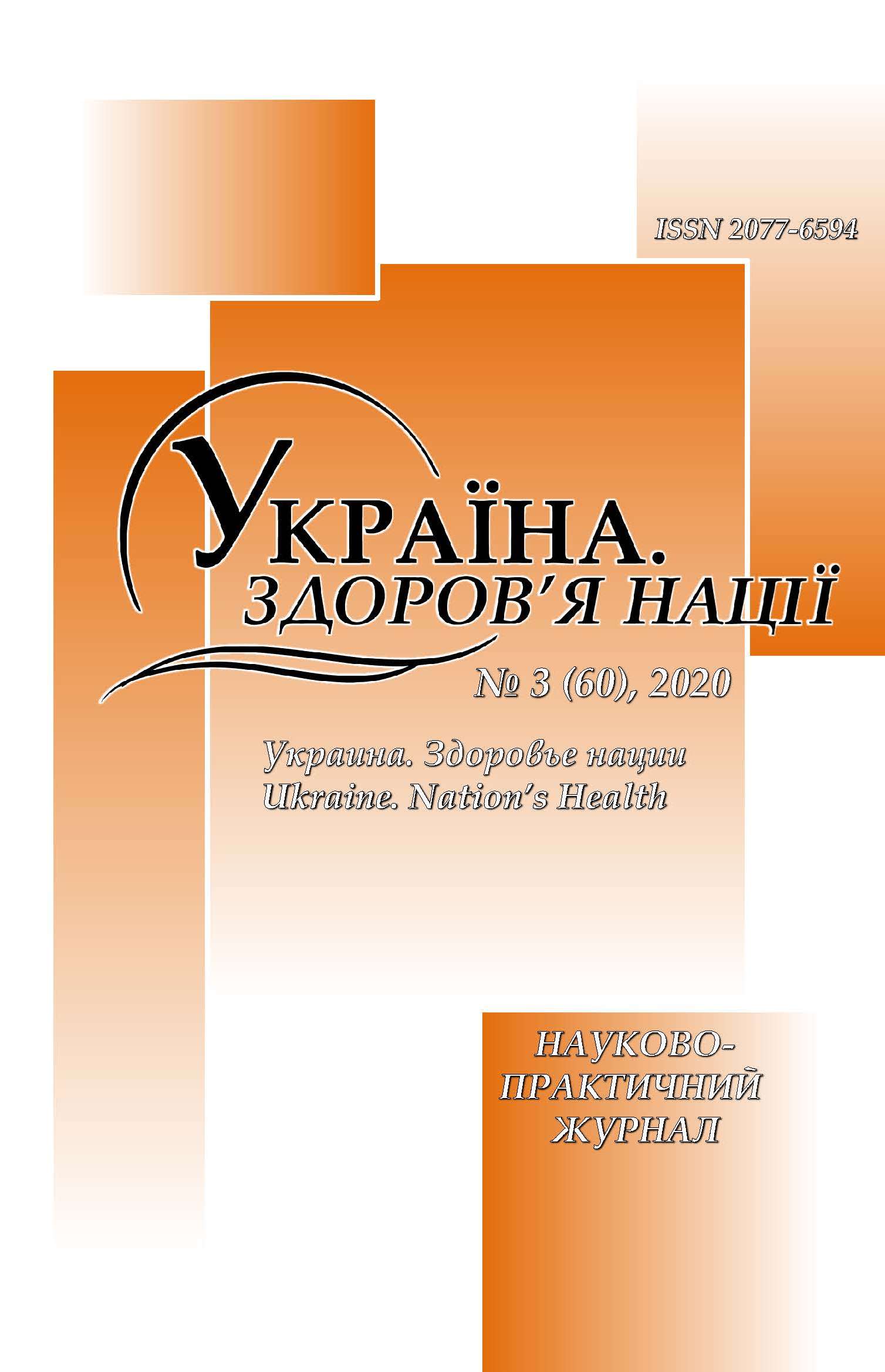Analysis of selected risk factors of osteoporosis
DOI:
https://doi.org/10.24144/2077-6594.3.2020.208618Анотація
Aim: presently, osteoporosis represents a chronic, non-infectious disease with an expanding health-related, socioeconomic, and society-wide dimension. The aim is to identify the risk of a bone fracture, and to map out the risk factors related to the development of osteoporosis.
Materials and methods. The sample consisted of 151 patients with the average age of 64.2 (SD±8.9) registered in Ostreocentrum. To identify the risk of an osteoporotic fracture, we have utilized the FRAX (Fracture Risk Assessment Tool) method and densitometric screening. In relation to osteoporosis, we monitored the risk factors such as age, gender, family history, associated diseases, and nutrition.
Results. The results of our monitored group confirmed the fact that the risk of osteoporosis development does rise along with age. Higher prevalence occurred in women than in men. We can state that positive family history and the nutrition do influence development of osteoporosis. Associated diseases did not appear to be statistically significant in relation to the development of osteoporosis.
Conclusions. The results show that both primary and secondary prevention of osteoporosis need to be strengthened.
Посилання
Cooper, C., Ferrari, S. Compendium of Osteoporosis. Available from: http://share.iofbonehealth.org/WOD/ Compendium/IOF-Compendium-of-Osteoporosis-WEB.pdf [accessed: October 21, 2019].
Hernlund, E., Svebdom, A., Ivergard, M., et al. Osteoporosis in the European Union: Medical Management, Epidemiology and Economic Burden: A report prepared in collaboration with the International Osteoporosis Foundation (IOF) and the European Federation of Pharmaceutical Industry Associations (EFPIA). Arch Osteoporos, 2013; 8: 115-136. doi: 10.1007/s11657-013-0136-1.
Špániková B. Secondary osteoporosis of cancers. Via Pract, 2018; 15(1): 17-20. ISSN 1339-424X (on-line).
Payer J., Killinger Z., Jackuliak P., Kužma, M. Postmenopausal osteoporosis: standard diagnostic and therapeutic procedure. Clin Osteol, 2018; 23(1): 18-27. ISSN 2571-1334 (on-line).
Baňárová P., Kereková P., Petríková Rosiková I., Černický M. The presence of risk cases of osteoporosis in patients diagnosed with osteoporosis. Zdravotnícke listy, 2013; 1(2): 4-10. ISSN 2644-4909 (on-line).
Pouresmaeili F., Kamalidehghan, B., Kamarehei, M., Goh, Y.M. A comprehensive overview on osteoporosis and its risk factors. Ther Clin Risk Manag, 2018; 4: 2029-204. doi: 10.2147/TCRM.S138000.
Belovičová, M., Vansáč, P. Selected aspects of medical and social care for long-term ill persons. Towarzystwo Slowaków w Polsce, Kraków, 2019, 153 p. ISBN 978-83-811110-9-6.
FRAX. 2019. Available from: https://www.sheffield. ac.uk/FRAX/tool.aspx?country=44. [accessed: December 12, 2018].
Payer J., Killinger, Z. Osteoporóza. vyd. Herba, 2012. 250 s. ISBN 978-80-891719-4-1.
Némethová E., Killinger Z., Payer J. A comparison of the risk of osteoporotic fractures in Slovakia and neighboring countries. Osteologický bulettin, 2013;18(2): 44-52. ISSN 1211-3778.
Tu K.N., Lie J.D., Wan CH.K.V., et al. Osteoporosis: A review of treatment option. PT. 2018 Feb;43(2):92-104.
Broulík P. Postmenopausal osteoporosis. Practical advice of doctors. vyd. Praha: Mladá fronta, 2011. 47 s.
Tomková S, Vrško M. Osteoporosis in men: what has changed? Clin Osteol, 2019; 24(3): 93-100. ISSN 2571-1334 (on-line).
Fraser L., Langsetmo L., Berger C. et al. Fracture prediction and calibration of a Canadian FRAX tool: a population-based report from CaMos. Osteporos Int, 2011; 22(3): 829–837. doi: 10.1007/s00198-010-1465-1.
Cohen J.E., Wakefield C.E., Cohn R.J. Nutritional interventions for survivors of childhood cancer. Cochrane Database Syst Rev, 2016; 22(8): CD009678. doi: 10.1002/14651858.
Bednarek A., Klepacz R., Surtel A., Mazur A., Saran T., Zarzycka D., Emeryk A. Influence of environment on residence and selected demographic and clinical parameters of preschool children with IgE-dependent asthma. Ann Agric Environ Med. doi:10.26444/aaem/104666.
Gabrhelová K., Miklovičová E. Lifestyle of pacients with osteoporosis. Ošetrovateľský obzor, 2010; 7(1-2): 13 – 15. ISSN 1336-5606.
Zamboriová M. Diétny systém. Dietológia a liečebná výživa I. vyd. Košice: ŠafarikPress, 2018. s. 115-142.
Levis S., Lagari V.S. The role of diet in osteoporosis prevention and management. Curr Osteoporos Rep, 2012; 4(10): 296 – 302. doi: 10.1007/s11914-012-0119-y.
Szamosi S., Horváth, A., Szekanecz, Z., Szücs, G. Vitamin D metabolism and osteoporosis in systemic sclerosis. Orv Hetil, 2017; 158 (32): 1252 – 1258. doi:10.1556/650.2017.30816.
Bačová I., Bachledová S., Gáborová M. et al. Karencia vitamínu D u dospelej populácie sledovanej v ambulancii všeobecného lekárstva. Lek obz (med Horizon), 2020; 69(1): 2-6. ISSN 0457-4214.
Watts N.B., Lewiecki E.M., Miller P.D., Baim S. National osteoporosis foundation 2008 clinician’s guide to prevention and treatment of osteoporosis and the world health organization Fracture Risk Assessment Tool (FRAX): what they mean to the bone densitometrist and bone technologist. J Clin Densitom, 2008; 11(4): 473–477. doi:10.1016/j.jocd.2008.04.003.
Kendler D.L., Martin F., Zerbini C.A.F. et al. Effects of teriparatide and risedronate on new fractures in post-menopausal women with severe osteoporosis (VERO): a multicentre, double-blind, doubledummy, randomised controlled trial. The Lancet, 2018; 391(10117): 230-240. doi:10.1016/S0140-6736(17)32137-2.
Koller T., Kollerová J., Payer J. Bone metabolism disorders in liver and gastrointestinal diseases. Osteologický bulettin, 2015; 20(1): 21-27. ISSN 1211-3778.
Raška I. Type 2 diabetes mellitus and bone quality. Clin Osteolol, 2018; 23(3): 120-125. doi:10.21101/cejph.a4717.
##submission.downloads##
Номер
Розділ
Ліцензія
Автори, які публікуються у цьому журналі, погоджуються з наступними умовами:
1. Автори залишають за собою право на авторство своєї роботи та передають журналу право першої публікації цієї роботи на умовах ліцензії Creative Commons Attribution License, котра дозволяє іншим особам вільно розповсюджувати опубліковану роботу з обов'язковим посиланням на авторів оригінальної роботи та першу публікацію роботи у цьому журналі.
2. Автори мають право укладати самостійні додаткові угоди щодо неексклюзивного розповсюдження роботи у тому вигляді, в якому вона була опублікована цим журналом (наприклад, розміщувати роботу в електронному сховищі установи або публікувати у складі монографії), за умови збереження посилання на першу публікацію роботи у цьому журналі.
3. Політика журналу дозволяє і заохочує розміщення авторами в мережі Інтернет (наприклад, у сховищах установ або на особистих веб-сайтах) рукопису роботи, як до подання цього рукопису до редакції, так і під час його редакційного опрацювання, оскільки це сприяє виникненню продуктивної наукової дискусії та позитивно позначається на оперативності та динаміці цитування опублікованої роботи (див. The Effect of Open Access).

